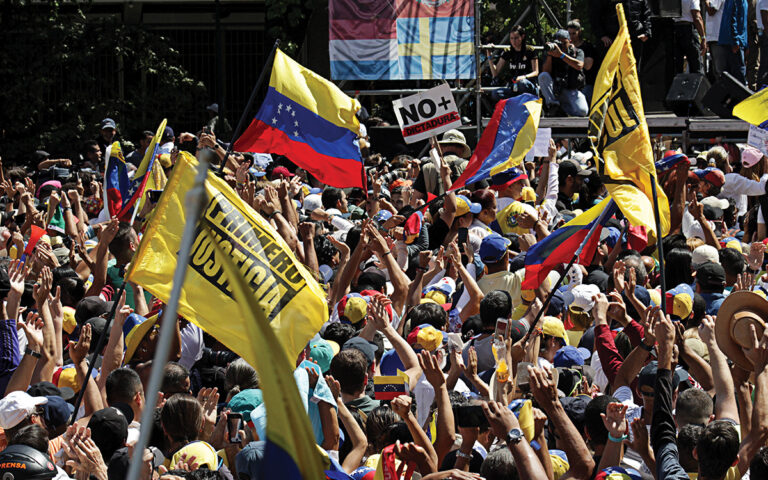Sad news that Bob Moses, a leader of the civil rights movement, died on July 25, 2021. We commemorate his work with a replay of his appearance on Reality Asserts Itself with Paul Jay, first released on June 20, 2014. Mr. Moses says America from 1875 down to the civil rights movement, was slavery by another name.
STORY TRANSCRIPT
PAUL JAY, SENIOR EDITOR, TRNN: Welcome back to The Real News Network. I’m Paul Jay in Baltimore, and this is Reality Asserts Itself. We’re continuing our series of interviews with Bob Moses, who was one of the most influential leaders of the civil rights movement. He’s the founder of the Algebra Project. He was also one of the leaders of the Mississippi Summer project.
And Bob joins us again in the studio.
Thanks for joining us.
BOB MOSES, EDUCATOR AND CIVIL RIGHTS ACTIVIST: Yeah.
JAY: So, one more time, Bob is an educator, a civil rights activist. During the ’60s he was a field secretary for SNCC. He also was an outspoken critic of the Vietnam War. And he’s the founder of the Algebra Project. As I mentioned, he’s also the author of Radical Equations: Civil Rights from Mississippi to the Algebra Project, coeditor of Quality Education as a Constitutional Right: Creating a Grassroots Movement to Transform Public Schools.
Thanks for joining us.
MOSES: Yeah.
JAY: So we’re going to pick up where we were. I asked you at the end of last segment what you learned from the hootenannies, and you talked about that there seemed to be a lynching every week in Florida. What else did you pick up in terms of the politics of that period and politics of the milieu? There’s a lot of talk about socialism. There’s a lot of talk about, you know, a different way to have–you know, who has power and who owns stuff. At the same time, there’s tremendous pressure in the culture and the media against even talking about that kind of stuff. As you mentioned, McCarthyism, you know, it’s considered un-American to even discuss such things.
MOSES: Yeah.
JAY: You’re old enough to start understanding all this.
MOSES: Yeah, but I’m not really attracted to politics as I see it around me in Harlem, or really to the kind of talk that young people would do who were part of that, you know, sort of environment. I’m really focused. I’m busy. Right? So Stuyvesant is–my last two years at Stuyvesant were in the morning session, so school goes from 8:00 to 12:00. Takes me an hour to get to school. I have a job, right? So I leave school, I’m working at NYU medical library. And then I’m playing basketball at the Harlem Y, right, so three nights a week.
JAY: And if I’d asked you then what you think you’d be doing five or ten years later, what would have been your answer?
MOSES: Well, so I’m a kid who hasn’t thought much about career, alright? So when I get to college and I’m majoring in philosophy, everybody’s asking me, you know, what are you going to do with philosophy, right, and I’m not caring what the answer is.
JAY: But you’ve got an uncle who’s a rising officer in the military. You’ve got another uncle who’s an architect. Did you think you were heading towards some kind of professional career?
MOSES: No, no. I actually didn’t think. And the uncle who was the–I wasn’t really looking at my uncles as role models. And there wasn’t any pressure in my family, you know, towards career. And so I’m a kid who decides that I’m going to study philosophy, and I really don’t care. People are asking me, what are you going to do with philosophy? Right? And so I have no idea, but I’m interested in it.
JAY: Well, if you’re not that interested in the politics at the time, where do you get–when do the coins starts dropping for you that you’re going to start committing yourself to the civil rights movement?
MOSES: The sit-ins. Right?
JAY: When was that and what happened?
MOSES: When those pictures start appearing in 1960, right, in February, March, right, 1960, I’m watching the young people sit in through the lens of The New York Times. This is the first time that young black men and women are on the front page of The New York Times—
JAY: Tell us a bit of the story of the sit-in.
MOSES: –talking to the nation about what I feel inside now, right? Right? ‘Cause I have now gone through Hamilton. Hamilton is a fraternity school, right? When I get there, there are three blacks in a small school, 525 students, right, at most three black students. It’s–the guy who interviews me says, you know we’re a fraternity school. I say yes. And basically that means, you know that you cannot join any of these fraternities. Right?
So I make a trade-off about the school I want to go to. I don’t want to go down South and into the segregated, you know, South, and I want to go to a small school where I can play ball, right? So I played basketball through college. And I want a good education. Right? So I make a trade-off. And I actually get funded, I get a full scholarship to go to this school, right? And so that’s what happens. I go to Hamilton, and then I go leave Hamilton and go to Harvard, right? Again, Harvard in the 1950s, you know, blacks are scarcer than hens’ teeth, right? So I’m the only black in the philosophy department in the graduate school at Harvard.
I think that I’m going to Harvard so that I can really test how I stand. I’m really disappointed when my roommate tells me that the professor tells him that he’s not really–he doesn’t say afraid, but he’s uneasy about calling on me, right? So what it means is I don’t escape this issue of some objective, you know, [crosstalk]
JAY: Harvard, one of Harvard’s role, at least, is to train people to join the ruling elite and become those who can help rule one way or the other. We’ve seen it–in a more modern sense, we see Barack Obama winds up president. I mean, does somewhere–.
MOSES: I’m not thinking about that. I’m thinking–.
JAY: No, I’m saying you are, but Harvard as an institution isn’t. It’s certainly one of the things it does.
MOSES: And I know that. I mean, so a part of it: who’s going to Harvard? Well, black people are going to Harvard who are part of the black elite, right? And I know about them because I know about them through my cousins, right, because through their family circumstances, they are part of the black elite. Right? And they’re sending their kids to private schools and then on to Ivy League schools. But my part of the family is not that at all. We’re not doing that. So I know about it, but I’m not part of it.
…
JAY: So you see the sit-ins. Tell us what–in 1960. So you see these sit-ins. Tell us the story of the sit-ins and then what effect that had on you.
MOSES: So what I did when I saw the sit-ins–this is the black students at the HBCUs, those darkly black universities, have decided that they’ve had enough, right? And so they begin sitting in at Woolworths and the five-and-dime stores at the lunch counters.
JAY: This is right across the country?
MOSES: Across the Mid-South, right? So it’s Atlanta, which is not the Mid-South, but Atlanta is a big city in the Mid-South, right? But Tennessee, North Carolina, right, Kentucky, right, and some in South Carolina–Orangeburg, South Carolina. Right? So something’s up, right? And what I see watching their faces is I see them looking like I’m feeling inside, right, based on Stuyvesant, Hamilton, Harvard, right?
JAY: And this is a time when young black students could not eat at the lunch counter at Woolworth stores.
MOSES: Well, the South is still–you know, it’s apartheid of the South. I mean, the South really is just running an apartheid system around Jim Crow. You know Blackmon’s book Slavery by Another Name? And so Doug Blackmon, he really names this era, ’cause we’re really talking about the era from roughly after 1875, when the Democrats, by, really, terror and violence, overthrow the state legislature in Mississippi, and William Alexander Percy, who is this plantation owner from Greenville, goes into the Mississippi legislature to oversee the articles of impeachment against Adelbert Ames, who was the governor that has been elected by black votes of Mississippi–and he’s the respectable face of this terror, right? And so from that era right down to the civil rights movement, I think he names it. It’s slavery by another name.
Francis Biddle is–it’s amazing. He’s the attorney general under Roosevelt. In 1941, December 12, he issues Circular 3591 to every state attorney general and says that from now on you should prosecute peonage not as indebtedness, but prosecute it as involuntary servitude and slavery. Right? So what Blackmon does is he investigates as a Wall Street Journal reporter. He asked a really amazing, interesting question. He said, what if we looked at American corporations vis-à-vis the industrialization and the use of black labor in this country in the same way as we looked at German corporations vis-à-vis the Holocaust? Right? And he writes an article on the front page of The Wall Street Journal about this and gets an amazing response from all over the country, people who are writing him about relatives, right, that got caught up in this involuntary servitude, slavery of the founding of the steel industry, right, in this country. Right? And so then he goes off and does this investigation, uncovering tens of thousands of black young men who are conscripted on vagrancy and sent into the mines, right, in Birmingham, right?
So one way of thinking about what was happening with the students, right, in 1960–I didn’t understand it then, but they are actually breaking, right, this sort of era, right, of slavery by another name, which happens after the Civil War and after Reconstruction has ended. And it ends in Mississippi in 1875 when the Democrats take over by terror and violence. So you’ve got another almost three-quarters of a century.
JAY: Well, we are going to continue this discussion with Bob Moses. Please join us for the next segment on The Real News Network.






